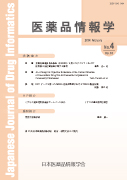Volume 15, Issue 4
February
Displaying 1-5 of 5 articles from this issue
- |<
- <
- 1
- >
- >|
Original article
-
2014 Volume 15 Issue 4 Pages 147-154
Published: 2014
Released on J-STAGE: April 02, 2014
Download PDF (593K) -
2014 Volume 15 Issue 4 Pages 155-164
Published: 2014
Released on J-STAGE: April 02, 2014
Download PDF (371K)
Short communication
-
2014 Volume 15 Issue 4 Pages 165-168
Published: February 28, 2014
Released on J-STAGE: April 02, 2014
Download PDF (447K)
Useful website
-
2014 Volume 15 Issue 4 Pages N17-N18
Published: 2014
Released on J-STAGE: April 02, 2014
Download PDF (631K)
Instruction of an institution
-
2014 Volume 15 Issue 4 Pages N19-N21
Published: February 28, 2014
Released on J-STAGE: April 02, 2014
Download PDF (2379K)
- |<
- <
- 1
- >
- >|
